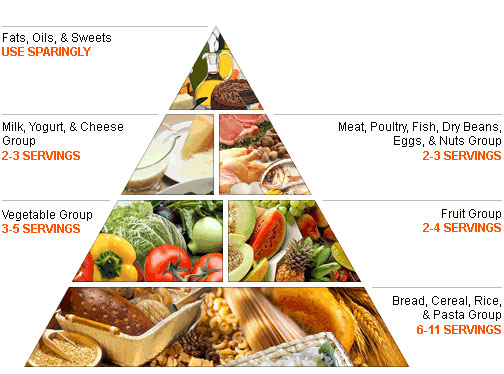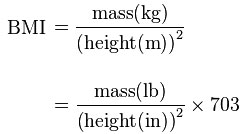Healthy Lifestyle Choices
The Healthy Eating Pyramid
What Is the Food Pyramid?
The Healthy Eating Pyramid is a guide developed by the U.S. Department of Agriculture to help you plan a healthy diet.
Why Is it Helpful?
The Pyramid helps you choose what and how much to eat from each food group so that you:
- Get the nutrients you need.
- Consume the correct amount of energy to control your weight.
- Restrict your intake of fats, sugar or alcohol.
Food Groups
The Healthy Eating Pyramid has six levels. Foods from the six major food groups are shown in the levels of the Pyramid. The food groups are:
- grains;
- vegetables;
- fruits;
- milk and dairy products;
- meat, fish, beans and nuts;
- oils and fats.
Each of these food groups provides some of the nutrients you need (but not all). Foods from one group cannot replace those from another and they are all equally important. For good health, you need them all.
The first group: This group is mainly derived from grains. It includes breads, cereals and pasta. These foods should make up the greatest part of your daily diet. Aim at 6 to 11 servings a day.
The second and third groups: These are foods from plant sources – vegetables and fruits. Most people need to eat more of these foods as they supply fiber, vitamins and minerals. The recommendation is to eat 3 to 5 servings of vegetables and 2 to 4 servings of fruits daily.
The fourth group: These are dairy products such as milk, yoghurt and cheese. These foods are an important source of protein and calcium. The recommended daily amount is 2 to 3 servings per day.
The fifth group: This includes meat, poultry, fish and eggs. Dried beans and nuts are also in this group. Recommended daily servings are 2 to 3. These foods are important because they provide protein, calcium, iron and zinc.
The last group: Fats, oils and sugars. These foods provide taste and calories. A small amount of oil or fat is needed but it should be used sparingly due to the high energy content. Sugar will contribute extra calories with no other nutritional benefits.
The number of food servings a person needs depends upon their sex, age, body type and physical activity. We recommend that you consult a dietitian to determine your exact needs.
Exercise
You have probably heard it a thousand times already and would like to hear something new, but here it is again. Exercise, combined with a reasonable diet, is the most effective way to control your weight.
13 Benefits of Exercising
A physical activity program will bring you long-term, as well as short-term benefits. The beneficial effects of exercise will help to keep you motivated and help you to burn calories.
Here is how exercise can improve your quality of life:
- It tones and strengthens your muscles. This improves your looks, whether you are male or female. It also raises your metabolic rate and so helps burn more calories.
- Increases your energy and endurance levels.
- Improves your posture and coordination and helps you feel “lighter”.
- Strengthens your immune system.
- Decreases the risk of osteoporosis. Regular exercise delays bone loss and promotes bone formation.
- Improves the quality of your sleep.
- Reduces the risk of developing high blood pressure.
- Lowers stress and boosts mood by causing your body to release natural mood-enhancing endorphins during physical activity. Statistics show that people who do physical exercise are three times less likely to be depressed than less active people.
- Improves your self-esteem because it helps you feel good about your improving body shape.
- Gives you a break from your daily routine, workouts can be fun.
- Improves the circulation of blood and oxygen to vital organs.
- Better blood circulation improves your skin color and texture.
- Your improved fitness will result in enhanced sexual performance.
How-to’s
- Consult with your doctor when choosing the program. You may need a brief medical check-up to make sure that your chosen program is appropriate for you.
- Choose a realistic, achievable fitness goal.
- Choose activities that you enjoy.
- Begin with a low intensity exercise plan and then increase your exercise slowly.
- One step at a time, this is the key to healthy exercise.
- Exercise with a friend.
- Work out at different times of the day and then write down how you feel before and after each work out. Discover the best time of day to work out and then try to exercise regularly at that time.
- Avoid any exercise that hurts.
- Stop exercising and consult with your doctor if nausea, dizziness, breathlessness, or persistent muscle soreness occur.
- Remember: slow and steady, especially in the early stages.
- Exercise works best when accompanied by a healthy diet.
- Don’t make your lack of leisure time an excuse. The busier and more stressful your life is, the more you need to set aside time to exercise. Your health has a high priority.
Get More Exercise into Your Life
The gym is not the only place where you can exercise. Once you bring regular exercise into your lifestyle, you’ll be surprised at how quickly it will become a habit. You can combine your regular fitness training with normal daily activities. Here are a few ideas, I’m sure you can think of more like this:
- Why not turn on the music and do chores at a brisk pace, exaggerating your movements?
- Get off the bus two stops before your destination and walk the rest of the way.
- Use the stairs instead of the elevator.
- Get rid of the power lawn mower or the riding mower. A push mower will make you burn up extra calories.
- Play actively with the kids. Football, playing catch or Frisbee throwing is not just fun, it burns those extra calories.
- At the supermarket, carry your bags out to the car without using the shopping cart. Take care not to lift loads that are too heavy, though.
- Take the “long way around” if you are walking somewhere.
- Get up to change the TV channel instead of using the remote. This will engage your leg muscles.
- Walk to a co-worker in your office and chat face to face instead of sending an e-mail or instant message.
- Jump rope. You can do this inside the house if it rains or is too cold outside.
Body mass index
The body mass index (BMI), or Quetelet index, is a measure of relative weight based on an individual’s mass and height.
Devised between 1830 and 1850 by the BelgianpolymathAdolpheQuetelet during the course of developing “social physics”,[2] it is defined as the individual’s body mass divided by the square of their height – with the value universally being given in units of kg/m2.
Even though many other differently calculated ratios have been invented, others haven’t been used as often.
BMI can also be determined using a table,
Or, from a chart which displays BMI as a function of mass and height using contour lines, or colors for different BMI categories, and may use two different units of measurement.
A graph of body mass index as a function of body mass and body height is shown above. The dashed lines represent subdivisions within a major class. For instance the “Underweight” classification is further divided into “severe”, “moderate”, and “mild” subclasses.
The BMI is used in a wide variety of contexts as a simple method to assess how much an individual’s body weight departs from what is normal or desirable for a person of his or her height. There is however often vigorous debate, particularly regarding at which value of the BMI scale the threshold for overweight and obese should be set, but also about a range of perceived limitations and problems with the BMI.




